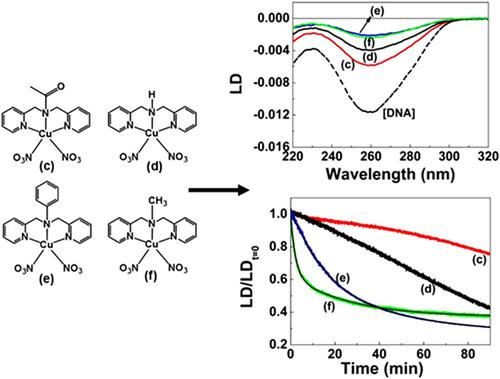当前位置:
X-MOL 学术
›
Bull. Korean Chem. Soc.
›
论文详情
Our official English website, www.x-mol.net, welcomes your feedback! (Note: you will need to create a separate account there.)
Effects of the Ligand Structure of Cu(II) Complexes on Oxidative DNA Cleavage
Bulletin of the Korean Chemical Society ( IF 1.7 ) Pub Date : 2021-08-04 , DOI: 10.1002/bkcs.12370 Ji Hoon Han 1, 2 , Ji Hoon Kim 1 , Maeng‐Joon Jung 3 , Seog K. Kim 1 , Yoon Jung Jang 4
Bulletin of the Korean Chemical Society ( IF 1.7 ) Pub Date : 2021-08-04 , DOI: 10.1002/bkcs.12370 Ji Hoon Han 1, 2 , Ji Hoon Kim 1 , Maeng‐Joon Jung 3 , Seog K. Kim 1 , Yoon Jung Jang 4
Affiliation

|
Cu complexes were synthesized by substituting the hydrogen of the amine group of basic ligand 2,2′-dipicoylamine (dpca) (complex 2) with CH3CO (complex 1), phenyl (complex 3), and methyl (complex 4), respectively, and their DNA cleavage activity was investigated using linear dichroism (LD) and electrophoresis. The DNA cleavage efficiencies of Cu complexes 3 and 4 with phenyl and methyl, which are electron-donating functional groups, turned out to be the highest, and LD magnitudes rapidly decreased at 260 nm. In particular, Cu complex 3 showed a rapid LD magnitude reduction to 63% of the total for 90 min, and to 50% of the total at 12 min. DNA cleavage efficiencies were high in the order of phenyl > methyl > HCH3CO, and the highest DNA cleavage efficiency was observed in the presence of electron-donating groups. The electrophoresis results are also consistent with the changes in LD spectra over time. The Cu complexes (1–4) were found to cleave DNA through oxidative pathways, and the major reaction oxygen species involved in DNA cleavage were the superoxide radical (·O2−), singlet oxygen (1O2), and hydroxyl radical (·OH).
中文翻译:

Cu(II)配合物配体结构对氧化DNA裂解的影响
Cu配合物是通过用CH 3 CO(配合物1)、苯基(配合物3)和甲基(配合物4)取代碱性配体2,2'-二吡啶甲胺(dpca)(配合物2)的胺基的氢而合成的,分别,并使用线性二色性(LD)和电泳研究它们的DNA切割活性。结果证明,Cu 配合物 3 和 4 与苯基和甲基(它们是给电子官能团)的 DNA 切割效率最高,并且 LD 幅度在 260 nm 处迅速下降。特别是,Cu 配合物 3 显示出 90 分钟内 LD 幅度迅速降低至总量的 63%,并在 12 分钟时降至总量的 50%。DNA 切割效率高,顺序为苯基 > 甲基 > HCH 3CO,并且在给电子基团的存在下观察到最高的 DNA 切割效率。电泳结果也与 LD 光谱随时间的变化一致。发现Cu复合物(1-4)通过氧化途径切割DNA,参与DNA切割的主要反应氧物质是超氧自由基(·O 2 -)、单线态氧(1 O 2)和羟基自由基( ·哦)。
更新日期:2021-08-04
中文翻译:

Cu(II)配合物配体结构对氧化DNA裂解的影响
Cu配合物是通过用CH 3 CO(配合物1)、苯基(配合物3)和甲基(配合物4)取代碱性配体2,2'-二吡啶甲胺(dpca)(配合物2)的胺基的氢而合成的,分别,并使用线性二色性(LD)和电泳研究它们的DNA切割活性。结果证明,Cu 配合物 3 和 4 与苯基和甲基(它们是给电子官能团)的 DNA 切割效率最高,并且 LD 幅度在 260 nm 处迅速下降。特别是,Cu 配合物 3 显示出 90 分钟内 LD 幅度迅速降低至总量的 63%,并在 12 分钟时降至总量的 50%。DNA 切割效率高,顺序为苯基 > 甲基 > HCH 3CO,并且在给电子基团的存在下观察到最高的 DNA 切割效率。电泳结果也与 LD 光谱随时间的变化一致。发现Cu复合物(1-4)通过氧化途径切割DNA,参与DNA切割的主要反应氧物质是超氧自由基(·O 2 -)、单线态氧(1 O 2)和羟基自由基( ·哦)。


























 京公网安备 11010802027423号
京公网安备 11010802027423号